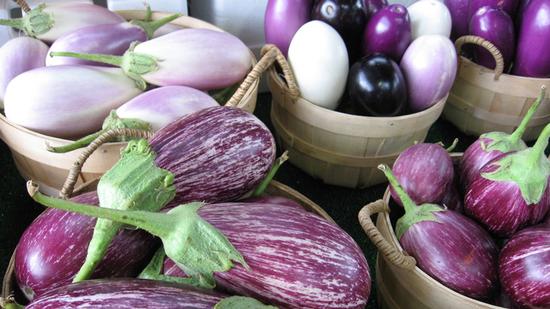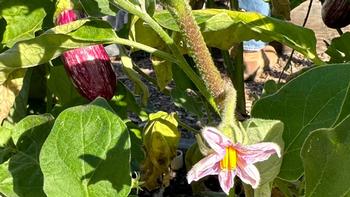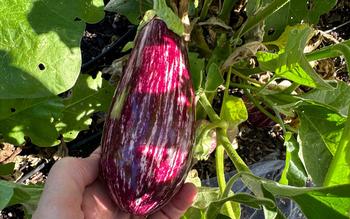News from the Edible Demo Garden
November 2023: The Versatile Eggplant

Eggplant varieties differ in size, shape, and color Photo Credit: flickr
There is always room for eggplant in the summer Edible Demo Garden. It’s an attractive well-behaved plant that doesn’t sprawl or climb and it thrives in the full sun. Two varieties of eggplant, ‘Orient Express’ and ‘Annina,’ were seeded in the greenhouse in March and transplanted to raised beds in May. Eggplant harvesting began the middle of August and continued through October. Approximately 45 pounds of eggplant have been contributed this year to the Indian Valley Organic Farm & Garden farm stand and CSA boxes.
What is Eggplant?
Eggplant belongs to the Solanaceae, or nightshade family and the species commonly grown in the US is Solanum melongea. Like its close relative, the tomato, eggplant is botanically classified as a berry, rather than a vegetable. It was first cultivated in southeast Asia and, by the early Middle Ages, was grown throughout the Mediterranean area. It was brought to the Americas by the Europeans.

Eggplant fruits grow on attractive plants with star-shaped flowers
Eggplant is known as aubergine in Britain, brinjal in India, melanzana in Italy, and talong in the Philippines. It most likely got its eggplant name from an oval-shaped white cultivar that resembles a goose egg. Many eggplant varieties of different sizes, shapes, and colors are now available to home gardeners. The two organic varieties planted in the Edible Demo Garden were selected for their taste, yield, and dependability. ‘Orient Express’ is an Asian variety with long and narrow, deep purple thin-skinned fruit. ‘Annina’ is more bell shaped with purple, lavender, and ivory streaks.
Why Grow Eggplant?
Eggplant doesn’t deserve to be underrated. It is an attractive plant, with large purple tinged leaves and lavender flowers, pretty enough to double as a landscape plant. Its fruit is versatile and used in the cuisine of many different countries. It can be saute’ed, baked, stewed, or fried and it is low in calories and a good source of vitamin C and potassium. In Asia and the Mediterranean, eggplant ranks among the five most important vegetable crops. It’s the basic ingredient in international favorites like moussaka, ratatouille, and baba ghanoush.
How to Grow Eggplant

Eggplants should be harvested while still small and firm with shiny skin
Eggplant is a warm season, sun-loving crop. The plants can be purchased as transplants or started earlier indoors from seed and then transplanted into the garden when the soil temperatures reach 65 to 75 degrees during the day and 60 to 70 degrees at night. In addition to at least 6 to 8 hours of sun, eggplant should have fertile, well-drained soil. It is a heavy feeder so extra fertilization may be needed for a good crop. Consistent watering throughout the summer is important and the addition of mulch around the plants can help conserve soil moisture. Once established, eggplant does not require a lot of additional care.
Eggplant fruits do not have to reach full size to be harvested. They should be picked when they are 6 to 8 inches long and still firm and shiny. Once they turn dull and brownish, they are too mature and no longer tasty. Picking regularly encourages the plant to keep producing fruit.
Click here for more information on growing edibles like eggplant.



